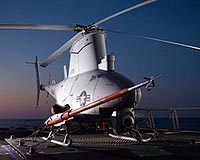| . |  |
. |
Monrovia, Calif. (UPI) Jul 6, 2009 The ability for a tiny man-made vehicle to fly through the flapping of wings while carrying its own energy source has been achieved, the company responsible said. AeroVironment Inc., a California company, announced that the Defense Advanced research Projects Agency had awarded it a contract extension to design and build a working prototype of a nano air vehicle. The contract extension is worth $2.1 million and continues through summer 2010 for work that uses "biological mimicry at an extremely small scale," which would allow for "new military reconnaissance capabilities in urban environments," a company release said. AeroVironment said its NAV reached a technological milestone when the craft, using two flapping wings and carrying its own energy source, managed controlled hovering flight. The company said the NAV used only the wings for propulsion and control. While in flight the NAV was able to climb and descend, fly forward and back and also left and right while under remote control. "The NAV program will push the limits of aerodynamic and power conversion efficiency, endurance, and maneuverability for very small, flapping wing air vehicle systems," Todd Hylton, DARPA program manager, said in a release. "The goals of the NAV program -- namely to develop an approximately 10-gram aircraft that can hover for extended periods, can fly at forward speeds up to 10 meters per second, can withstand 2.5-meter-per-second wind gusts, can operate inside buildings, and have up to a kilometer command and control range -- will stretch our understanding of flight at these small sizes and require novel technology development." DARPA, an agency within the U.S. Department of Defense, said the NAV program was initiated to develop an extremely small flying vehicle that could be used in either outdoor or indoor military missions. "The program will explore novel, bio-inspired, conventional and unconventional configurations to provide the warfighters with unprecedented capability for urban mission operations," the agency said on its Web site. DARPA foresees the program advancing technology in collision avoidance, navigation systems and hovering flight. "There are still many hurdles to achieve the vehicle we envisioned when the program was started," Hylton said in the AeroVironment release, "but we believe that the progress to date puts us on the path to such a vehicle." AeroVironment NAV Project Manager Matt Keennon said the propulsion and control systems were seen as the biggest challenges when NAV Phase I began. Keennon said Phase II, which is covered in the contract extension, will focus on longer flight capabilities for the NAV and improving its ability to switch from hover to forward flight and back. AeroVironment will also work to reduce the craft's size and weight while seeking to make it quieter. "All of these are distinct technical challenges in their own right that actually conflict with each other, making for an interesting and exciting path ahead," he said. Share This Article With Planet Earth
Related Links UAV News - Suppliers and Technology
 First Flight Of Land-Based MQ-8B Fire Scout
First Flight Of Land-Based MQ-8B Fire ScoutSan Diego CA (SPX) Jul 03, 2009 A Northrop Grumman MQ-8B Fire Scout Vertical Unmanned Aircraft System (VUAS), designated P7, has successfully completed first flight operations at Yuma Proving Grounds, Ariz. Unlike current Navy configured Fire Scouts, P7 was built in an operational land-based configuration. It is the first MQ-8B to fly without flight test instrumentation normally installed for developmental flights ... read more |
|
| The content herein, unless otherwise known to be public domain, are Copyright 1995-2009 - SpaceDaily. AFP and UPI Wire Stories are copyright Agence France-Presse and United Press International. ESA Portal Reports are copyright European Space Agency. All NASA sourced material is public domain. Additional copyrights may apply in whole or part to other bona fide parties. Advertising does not imply endorsement,agreement or approval of any opinions, statements or information provided by SpaceDaily on any Web page published or hosted by SpaceDaily. Privacy Statement |